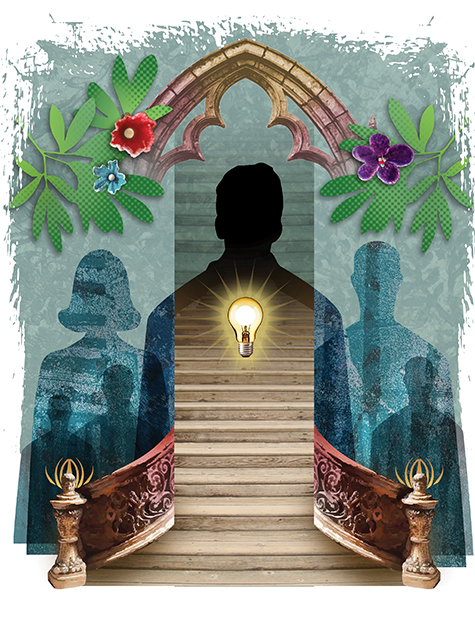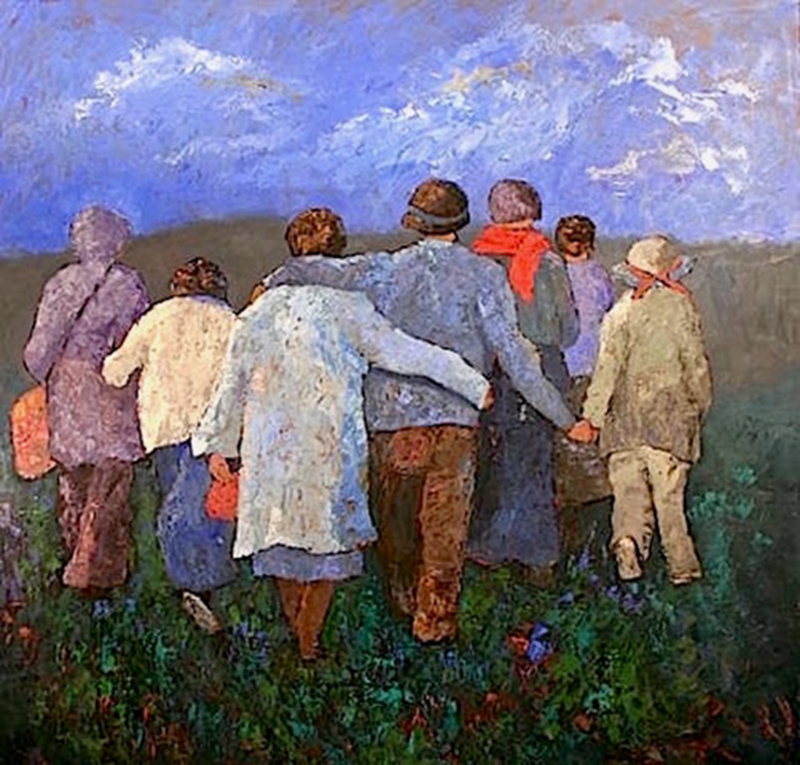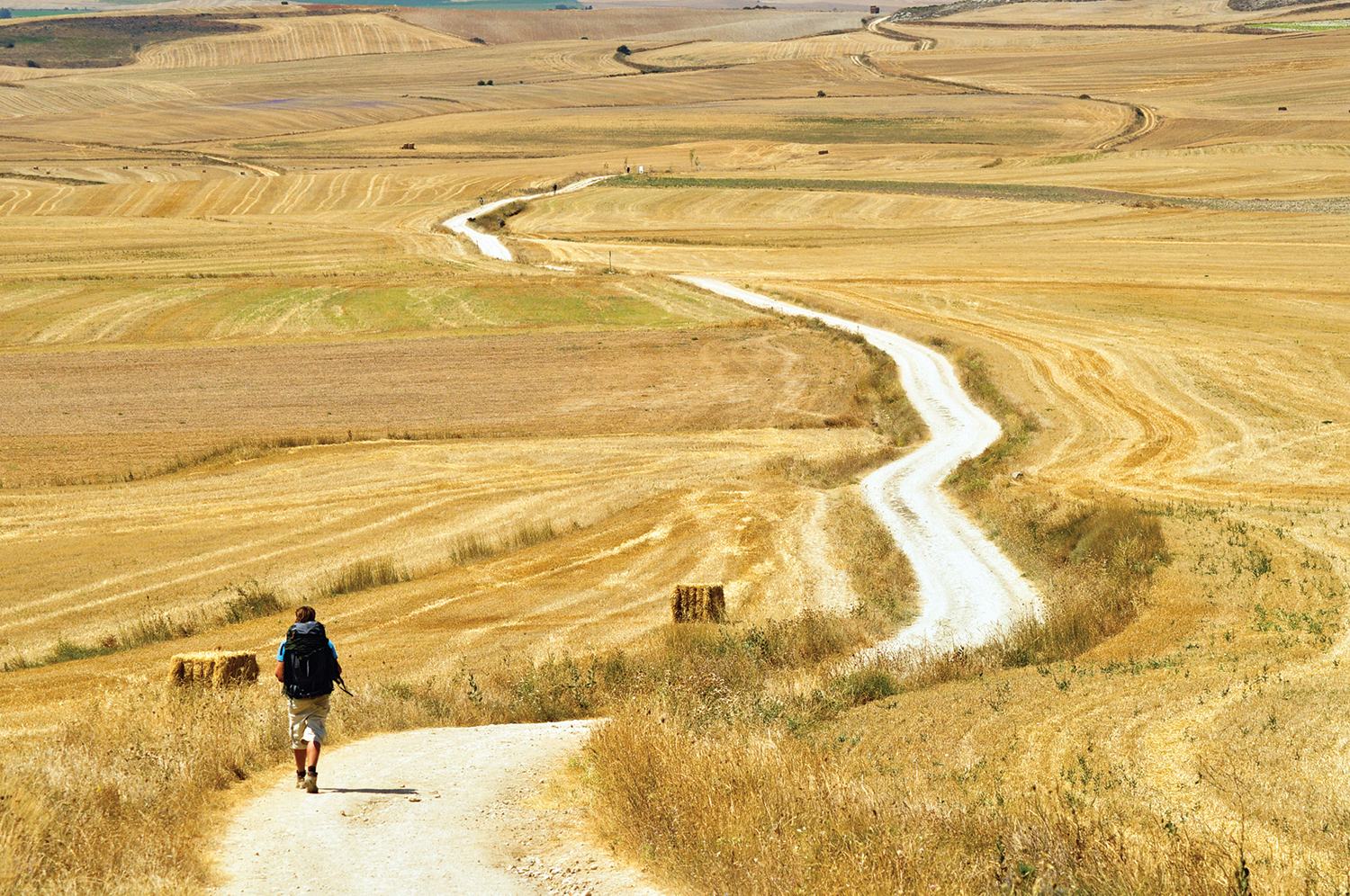
"When in doubt, just take the next small step." — Paulo Coelho, The Pilgrimage
There is a beautiful painting in warm, pastel colors by the artist Dorsey McHugh of seven figures we see only from behind. They are male and female, young and old. They walk with their arms across each other's shoulders or clasp hands, all traveling in the same direction. The work is titled, "Walking Each Other Home."
The painting beautifully distills the experience of being on a pilgrimage. The instinct to set out with a group of fellow sojourners toward a shared destination in search of some new knowledge remains embedded in the human psyche.
"There is within the human heart the need to set out on pilgrimage as if there is a power unlocked in the journey," Catholic priest and author Fr. Dwight Longenecker writes in his "The Power of Pilgrimage" essay.1 "There is a sense of seeking and finding — that through one's visit to the holy places there will be growth in grace, enlightenment and new inspiration."
Such quests recall the allegorical figures Odysseus, St. Brendan the Navigator and the many other mythological characters philosopher Joseph Campbell describes as heroes "with a thousand faces," who embark on an unknown path, stare down obstacles, and confront their doubts and fears to arrive at a newfound wisdom.2
Pilgrimages are unlike other travel experiences. Their principal goal isn't sightseeing, relaxation or even a desire for a new adventure. Pilgrimage is entwined with a spiritual aim. Muslims might set out for the Saudi city of Mecca, Jews for Jerusalem, and Christians for Rome and the Christian sites in the Holy Land. Buddhists travel to Bodh Gaya, India, where the Buddha is said to have attained enlightenment. Last year, nearly a half million pilgrims completed the Camino de Santiago in Compostela. It ends at the Cathedral of Santiago de Compostela in Galicia, Spain, where the remains of St. James the Apostle are buried.3
They walk, ride bicycles, ride horseback or travel by wheelchair. The number of people journeying along this sacred path has increased by 90% in the past decade, according to the Pilgrim's Reception Office on the Camino.4
What is the lure of pilgrimage? It marks a time when we remove ourselves from our usual surroundings and step outside of what feels safe and familiar. We alert our senses to a new environment and to what might be stirring inside of us. We seek to discover new parts of ourselves or perhaps rediscover those parts that have become buried in the dust of ordinary duties and daily routines. The goal is not information as much as transformation.
A TRANSFORMATIVE SHIFT
"Always in a pilgrimage, there is a change of mind and change of heart," the Irish poet and philosopher John O'Donohue observed.5 "We stand at the threshold, looking back and looking ahead," is how Catholic author and Servite Sr. Joyce Rupp, OSM, describes the journey in one of her poems.6

I personally witnessed the transformative power of pilgrimage take hold among the people who joined me on two separate contemplative/cultural pilgrimages that I led at lesser-known sacred sites in Italy over the past two years. The Greek term heterotopia refers to being in a place that disturbs our usual perceptions. It is a necessary starting point for any pilgrimage. On the first evening we come together, I encourage each person to put aside expectations of what they think could be or should be and to put themselves "in the way of grace," to borrow a favorite phrase of the poet Mary Oliver.
Call it grace, call it magic, call it the work of the Holy Spirit, but significant changes begin unfolding. An 80-year-old woman joined us on the first year's pilgrimage. She had been an early childhood specialist before her retirement. She told me before we left that she believed this trip would be her last. During our time together, she tried unfamiliar foods, walked farther than she thought she ever could, and made friends among people whose language she didn't speak. She not only joined us again on the following year's pilgrimage, but she has also signed up to come a third time.
Another woman told me that having the stamina to walk amid soaring gorges and complete an arduous uphill climb leading to a ninth-century Benedictine monastery gave her the courage to confront a cancer diagnosis she learned of right before she left on the trip.
The 80-year-old woman on the pilgrimage regretted not being able to make the rigorous hike to the Benedictine monastery that first year. Returning home from the trip, she signed up for physical therapy. She shed some pounds. The result: She was able to complete the trek the second year with just the aid of a cane.
We are all just walking each other home.
While there is only scattered research documenting the physical well-being pilgrims experience, there is abundant anecdotal evidence. Many of the nearly half million people who walked parts of the 485-mile El Camino de Santiago last year surely suffered foot blisters, the occasional pulled muscle and sore joints. However, those who complete the journey also say they experience enhanced flexibility and balance, improved muscle and joint strength, and better cardiovascular health, including lower blood pressure and bad cholesterol.7 Weight loss is also a frequent by-product.
"Today, walking enthusiasts are dramatically expanding their horizons by exploring ancient pilgrimage trails, fueling a global trend as record numbers of travelers take up multiday hikes infused with spiritual exploration and cultural heritage in countries around the world."
— 2024 Global Wellness Summit report
Because of these outcomes, the Global Wellness Summit cited walking pilgrimages as one of the key wellness trends of 2024.8 The summit is a four-day annual meeting that brings together those from medicine, science, business and academia who study wellness outcomes and trends.
"One silver lining that came out of the pandemic gloom is that people all around the world rediscovered the simple joys and health benefits that come from walking, and a purposeful connection with nature," the group wrote in its 2024 report. "Today, walking enthusiasts are dramatically expanding their horizons by exploring ancient pilgrimage trails, fueling a global trend as record numbers of travelers take up multiday hikes infused with spiritual exploration and cultural heritage in countries around the world."9
FORMING COMMUNITY, BUILDING BONDS
At the end of the Italy pilgrimage, I ask each person to share one thing they might do differently when they return to their usual routine. Several mention the desire to pause in the course of a day and pay attention to what is happening in the present moment to gain a better sense of having lived the day. Some said they intended to wake up earlier each day to see the sun rise. Others vowed to keep looking for examples of what one termed as "the good happening all around us."
The bonding that occurs, which fosters a sense of community, is another important benefit and draw. There wasn't a moment on the journeys I've led when an elderly member of the group didn't have the arm of one of the younger members to lean on as we went on walks or hikes.
The impulse to form community led two young men — Will Peterson and David Cable — to found Modern Catholic Pilgrim, a nonprofit that organizes pilgrimages for mainly young people.10 The idea sprang from an experience the two friends had shortly after graduating from University of Notre Dame and went on a walking pilgrimage in Kentucky, from Lexington to the Trappist Abbey of Gethsemani outside of Louisville. At the time, Peterson was working as a peace and justice intern at a parish in Lexington and Cable was teaching at a Catholic academy in Indianapolis.
While that organization is currently shifting its approach to provide resources rather than plan pilgrimages itself, the young people drawn to past Modern Catholic pilgrimages perhaps have more in common with the sojourners of the Middle Ages than today's wilderness campers. They don't carry tents or sleeping bags or rely on vehicles to transport them. Instead, they trust in the generosity of community members who volunteer in advance as hosts to receive, feed and house them along the journey.
"There is something empowering about walking alongside another person, having a shared destination, learning their story, hearing about their hopes and dreams, praying for and with each other," says Sam Vargo, who went on a seven-day walking pilgrimage from St. Nicholas of Tolentine Church in the Bronx, New York, to the National Shrine of St. Rita of Cascia in Philadelphia and narrated a short video on the journey.
We are all just walking each other home.
UNCOVERING OUR INNER PARADISE
The pilgrimage experience also has a way of alerting us, like an alarm bell, to what we need to change within ourselves. I've always been a perfectionist who grows impatient when things go wrong. On pilgrimage, lessons often arrive in unexpected ways. One day, the electricity went out in the part of town where I was lodging in Italy. I walked outside to see an elderly shopkeeper seated placidly on a wooden chair in front of her store. When I grumbled in Italian about the power outage, the woman simply smiled and said, "Pazienza," which means "patience."
The great Trappist monk and spirituality writer Thomas Merton once observed that the physical journeys we take are but the "symbolic acting out of an inner journey." The social justice activist Dorothy Day, co-founder of the Catholic Worker Movement, called her newspaper columns, "On Pilgrimage." Though Day traveled widely, her inner journeys often took place as she observed life from the easy chair she kept positioned by her second-story room window at the Catholic Worker house of hospitality in lower Manhattan.

Is the pilgrimage experience possible for those who, for various reasons, cannot attempt a physical journey? What can be their chair, their window into a new perspective?
If we look at our lives as a pilgrimage, we really don't have to travel anywhere. Each day that we live is like a stop at a shrine as we progress to our ultimate destination. We can stay home and still adopt a pilgrimage attitude. All that is necessary is to take a vow of wonder. In her essay, "The Necessity of Pilgrimage," writer Kathleen Tarr notes that this can mean relishing our random encounters and everyday conversations, being a humble listener, and being open and receptive to people and experiences that might at first seem "other."11
By taking a vow of wonder, by looking at our lives as a pilgrimage, Tarr writes, "We can alleviate the empty feelings that we are nothing more than digital bits controlled and distracted by algorithms and the media gods … Pilgrimage reclaims something of what's been trampled and lost."
There is a wonderful legend about St. Brendan the Navigator, a Celtic saint who embarks with some fellow monks in a boat to find the "Island of the Saints," which he has only seen in a vision. The monks sail in circles, visiting many of the same places again and again, each time seeing them from a different perspective.
Ultimately, St. Brendan realizes that what he was searching for was within him. "Only when his eyes are opened, does he see that this paradise he seeks is right with him," writes Celtic expert Christine Valters Paintner in an essay on St. Brendan.12
To some extent, we all possess a veil that hides the paradise we hold within. Pilgrimage — whether moving or stationary — helps remove that veil. When we lift that blinder, Merton has said, we are better able to see ourselves and "the stranger who is Christ, our fellow pilgrim and traveler."
"I felt in need of a great pilgrimage, so I sat still for three days and God came to me," the 15th-century Indian mystic and poet Kabir said. What, then, is to stop us from living every day of our lives as a pilgrimage? Truly, nothing.
Wherever we are, we are all just walking each other home.
JUDITH VALENTE is a retreat leader, journalist and author, including the recently published book, The Italian Soul: How To Savor the Full Joys of Life (Hampton Roads Publishing). She has won numerous awards for her work as a former correspondent for PBS, two NPR stations, The Wall Street Journal and as the author of several spirituality titles. She is also president of the International Thomas Merton Society.
NOTES
- "The Power of Pilgrimage," The Imaginative Conservative, February 2019, https://theimaginativeconservative.org/2019/02/power-pilgrimage-dwight-longenecker.html.
- Joseph Campbell, The Hero with a Thousand Faces (Princeton University Press, 1968).
- Michelle La Rosa and Brendan Hodge, "Camino Sets Another New Record for Pilgrims in 2024," The Pillar, January 8, 2025, https://www.pillarcatholic.com/p/camino-sets-another-new-record-for.
- "Camino de Santiago 2024 Pilgrim Statistics," American Pilgrims on the Camino, https://americanpilgrims.org/statistics/.
- John O'Donohue, A Celtic Pilgrimage with John O'Donohue (Sounds True, 2011).
- Joyce Rupp, Prayer Seeds: A Gathering of Blessings, Reflections and Poems for Spiritual Growth (Sorin Books, 2017).
- Paul Donovan, "The Pilgrimage to Santiago — The Talking Walking Cure," BHMA, July 30, 2018, https://bhma.org/the-pilgrimage-to-santiago-the-talking-walking-cure/; "Health and Wellbeing on the Camino: 3 Key Aspects to Achieve It," Follow the Camino, August 21, 2024, https://followthecamino.com/en/health-and-wellbeing-on-the-camino-3-key-aspects-to-achieve-it/.
- "Global Wellness Summit Releases 10 Wellness Trends for 2024," Global Wellness Summit, January 30, 2024, https://www.globalwellnesssummit.com/press/press-releases/gws-trends-2024/.
- "Global Wellness Summit Releases 10 Wellness Trends for 2024."
- Modern Catholic Pilgrim, https://www.moderncatholicpilgrim.com.
- Kathleen Tarr, "The Necessity of Pilgrimage," The Merton Seasonal 47, no. 3 (Fall 2022): 29-34.
- Christine Valters Paintner, "Feast of St. Brendan the Navigator — A Love Note from Your Online Abbess," Abbey of the Arts, May 13, 2018, https://abbeyofthearts.com/blog/2018/05/13/feast-of-st-brendan-the-navigator-a-love-note-from-your-online-abbess/.
Questions for Discussion
Author Judith Valente describes multiple ways a pilgrimage varies from a trip, hike or voyage. At its foundation, a pilgrimage involves a journey to a holy place that allows for a transformation of heart, mind and spirit.
- Have you made a pilgrimage to a sacred place? Did you set off with expectations, or did you find it more helpful to begin with an open mind and without a plan for what might occur?
- In a time when it can seem that we're bombarded with information or that the world around us can be overwhelming, think about whether there's a way to engage in a pilgrimage close to home. Is there somewhere significant you've been wanting to visit? Can you incorporate prayer or reflection? Set an intention or commit to a period of silence? What would be meaningful for you?
- Think about ways a pilgrimage experience might lead to greater contentment or joy in your life. Please see additional resources throughout this issue of Health Progress related to pilgrimage. Would you and a group consider a pilgrimage on behalf of celebrating and protecting creation (see page 18)? What about a walking journey that involves prayer and reflection (see pages 71 and 72 for Spanish and English versions of Prayer Service)?
- Are you ready and willing to embark on the inner journey of pilgrimage? To sit still and let God find you? To take a vow of wonder?
The Dorsey McHugh artwork “Walking Each Other Home” has been updated from the print version of Health Progress to show the more detailed, finished work online.
